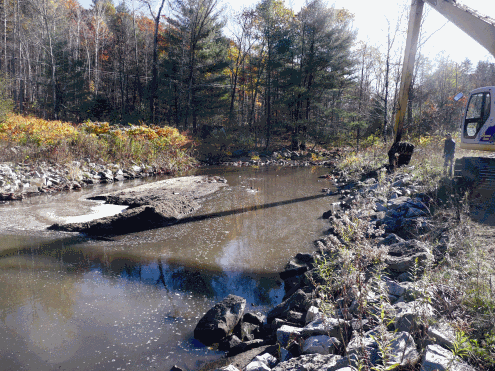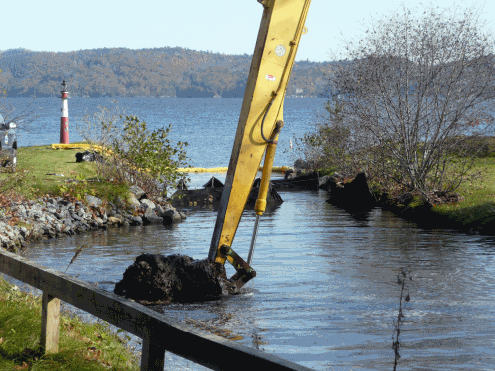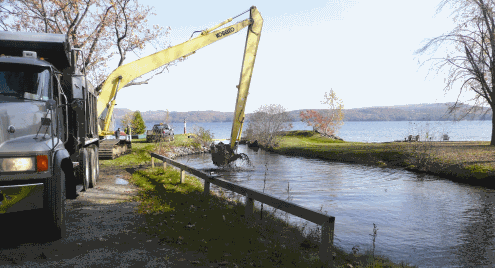
Michael Abrahamson, LGA lake steward, inspects a boat for invasive species at the Dunham’s Bay launch this summer. Dunham’s was a new location for the program this year.
The Lake George Association (LGA) has released preliminary results from the 2011 Lake Steward program. The LGA has managed training, hiring, supervision and reporting for the Lake Steward Program since 2008.
During the summer of 2011, LGA Lake stewards were posted at six different boat launches: Norowal Marina, Mossy Point, Hague Town Beach, Rogers Rock, Dunham’s Bay, and Million Dollar Beach. The stewards inspected 8,584 boats for invasive species, removed suspicious specimens from 52 boats prior to launch, and educated over 19,000 people about the threats of invasive species and how to prevent their spread.
“We had an extremely busy summer,” said Emily DeBolt, LGA director of education and outreach. “From over 8,500 boats inspected, 1,016 were at risk of bringing invasives into Lake George because they had been in a body of water other than Lake George during the past two weeks,” she said. “Right now, Lake George has only four invasive species. Some of our nearby water bodies have dozens.”
Upon launch, suspicious specimens were removed from 52 boats. Of those, 31 of the boats were carrying at least one invasive species. The LGA recovered 22 samples of Eurasian watermilfoil, 9 samples of curly-leaf pondweed, 4 of water chestnut and 2 of zebra mussel.
The stewards also inspected boats returning to the launch after boating on the Lake. Seventy-three of these boats had suspicious samples removed. Of these, 46 boats contained at least one invasive species. The LGA recovered 15 samples of Eurasian watermilfoil, 6 of curly-leaf pondweed, and 2 of water chestnut.
“Our stewards ask the boaters if they have taken preventative steps to guard against the introduction and spread of invasive species. This year, 75 percent of the boats we interacted with said they had,” said Walt Lender, executive director of the LGA. “While this is definitely positive news, and shows that people are becoming increasingly aware of the need to properly clean their boats, we want to see these numbers go even higher in the years to come,” he said.
The program grew significantly from its 2010 level, when 2,538 boats were inspected at four launches. Additional funding provided this year by the Lake Champlain Basin Program and the Lake George Park Commission allowed for more coverage during peak periods and at launches that receive the highest traffic. Additional financial support was provided by the Helen V. Froehlich Foundation. The program was originally conceived by the Invasive Species Task Force of the Lake George Watershed Coalition.
In addition to inspection, lake stewards collected additional data about lake users and invasive species spread. This information sheds light on the pathways of invasive species, and helps to identify target areas for early detection and control. A full report for the public is being prepared and will be ready later this year.
The program is closely coordinated with similar programs. Lake George, Lake Champlain, and the Adirondack Watershed Institute collaborate on training, printed materials, and data collection as members of a regional partnership, the Adirondack Park Invasive Plant Program (APIPP).

 The Lake George Association has constructed a new sediment pond at English Brook. The pond is designed to capture hundreds of tons of sediment before it enters Lake George.
The Lake George Association has constructed a new sediment pond at English Brook. The pond is designed to capture hundreds of tons of sediment before it enters Lake George.




 The Lake George Land Conservancy has announced the hiring of Chad Knisely as the Land Conservancy’s new Land Protection and Stewardship Specialist.
The Lake George Land Conservancy has announced the hiring of Chad Knisely as the Land Conservancy’s new Land Protection and Stewardship Specialist.


